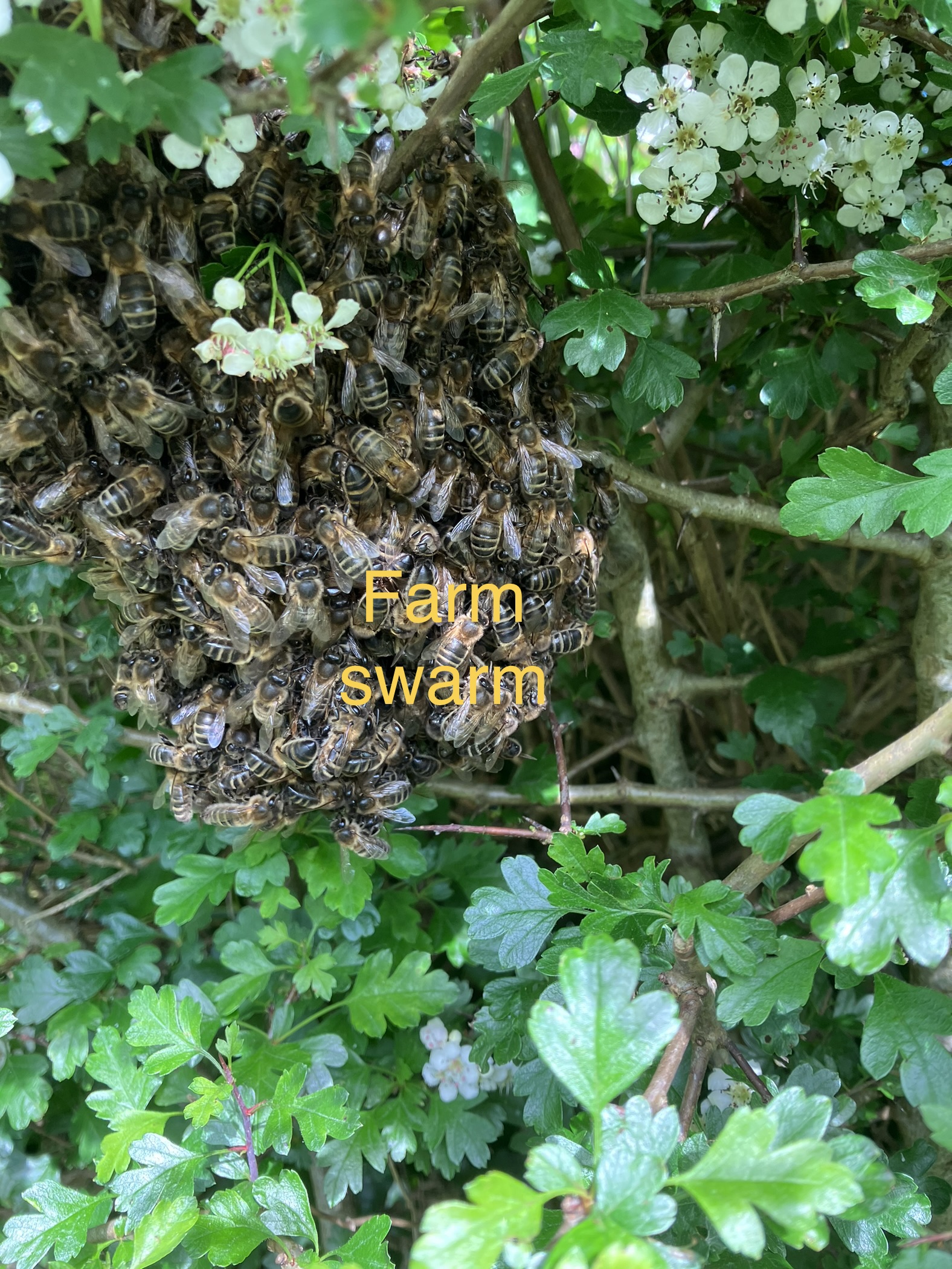Bees on the move
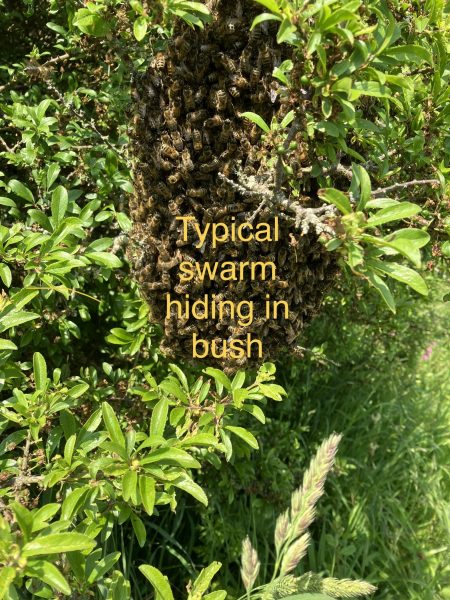
The recent hot weather has kept Bee expert Colin Rees busy taking your calls about swarming bees and this is just the start of the swarming season. His advice is leave this job to the experts.
Apparently, this has been a very swarmy season right across the UK, so it’s not surprising that I’ve had so many swarm reports locally. There have been swarms in the centre of Truro, at Charlestown and in the west of Cornwall – and the swarming season has hardly got underway yet!
What a contrast in the weather, going from rain, wind and cold to mid-summer overnight – at last! We have waited a long time for this and so have the bees. As I’ve said in earlier reports, the bees have had a long Spring to increase their colony size with we beekeepers (well, those of us who do) being unable to open up the hives to check on health, growth, stores, etc.
So, at the first signs of fine weather, these burgeoning colonies have decided that now is the time to swarm – and my word they’ve done that in earnest over the past two weeks. I have had swarm calls of one sort or another virtually every day, sometimes two in one day, over the past two weeks, a lot of them reporting swarms in rooves or in chimneys. The trouble is with such swarms, unless they are hanging in a cluster or have built comb for their nest, they are virtually impossible to retrieve without an excessive amount of time and effort on the beekeeper’s part.
Bee keepers – cancel your holidays!
Luckily, I have also had as many calls to retrieve swarms just hanging in a bush or on a tree branch and those I have collected and hived. The first one was from neighbors of a fellow beekeeper who had gone on holiday to the Isles of Silly.
I’ve made it quite clear to my course attendees, the days of Spring or Summer holidays are over once you become a beekeeper, but this was ignored in this case!
The beekeeper had hived a swarm from one of his colonies, but they absconded from their new hive. He caught them and put them in a poly nuc hive – then went on holiday!! I had a call from his neighbours to say his swarm had left the poly nuc and were in a tree in the apiary orchard.
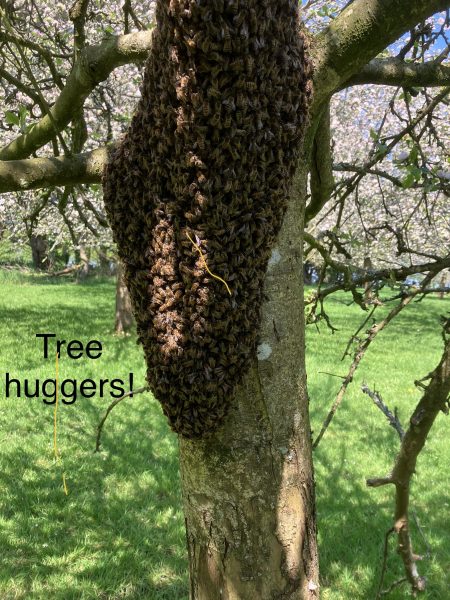
When I arrived, they were actually hugging the trunk of a tree – not always the easiest type of swarm to collect – but I brushed them down into my swarm box the best that I could, placed the inverted box onto a white sheet on the ground at the foot of the tree and left them until evening, when they had stopped flying. I collected them and put them in my garage overnight ready to be hived the following day.
Because they felt the nuc box was too small for them (one of the reasons for swarming is lack of space to grow the colony), I hived them in a standard brood box and they went in, no trouble at all. The following morning, on checking the hive, there was not a bee in sight! Obviously the brood box was also too small, so they came out and pitched in an adjacent blackthorn bush whilst the scouts looked around for a more suitable home.
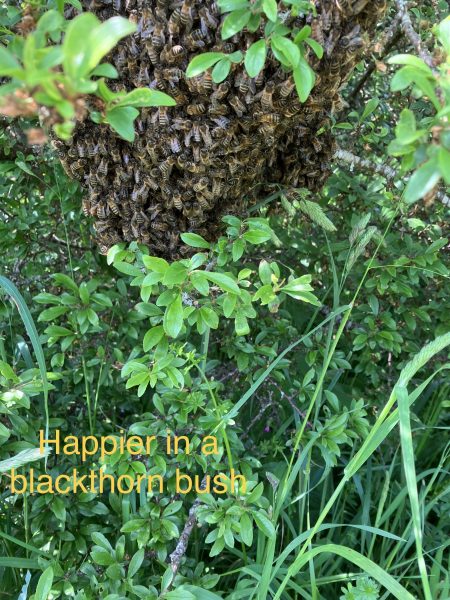
I put them in my swarm box again, put them in the garage overnight, and set up a jumbo brood chamber (about 50% bigger than a standard brood box) and hived them again the following day. The next morning – not a bee to be seen! There they were, hanging in virtually the same spot in the blackthorn bush, waiting of me to try my next trick – which was to add a queen excluder and super on top of the jumbo brood box.
Once hived, this seemed to satisfy their demand for space because they stayed and appear to be quite happy there. Phew!
You never read about things like this in beekeeping books, it’s all made to sound ordered, regimented even, and predictable. It’s not!
Bee baiting
The same day that I finally got the bees to stay, I had another call from my friend whose shed roof I use each year. I had been late putting up my bait hives this year because the weather had been so cold and miserable, but I finally had got round to putting them up once the weather broke. The minute this bait hive was put up, there were bees sniffing around the entrance, as if they’d been waiting for it. The next day I had the call to say the swarm had arrived. I collected it that evening and installed the bees in a poly nuc the following day, as it was only a small swarm, possibly a cast (secondary swarm). These bees were quite happy with a poly nuc, I’m relieved to say!
Two days later, another call from a farm deep in the countryside. The bees were in a hawthorn bush, again, only a small swarm – so where were the big, prime swarms from these two casts and where was the original colony?
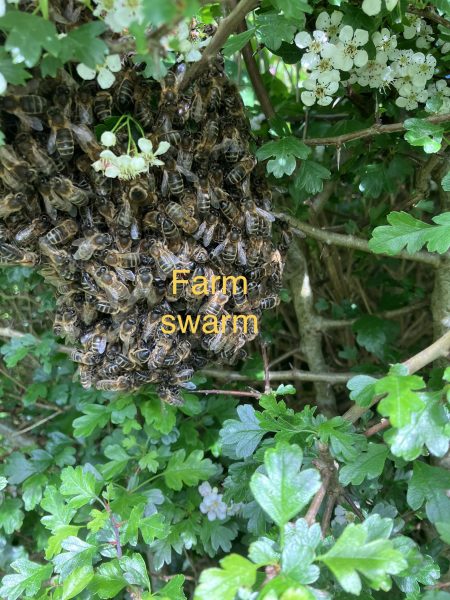
Presumably both swarms came from a wild colony somewhere in the woods, so treatment-free and managing Varroa quite well by themselves. I dropped them into my swarm box and brought them home that evening and they are quite happy in their nuc box. So not all colonies want only very large spaces, some are content with smaller volumes that they can grow into.
This was obviously the case with my next call, at St Just-in-Roseland. Somewhere there is a very large colony which swarmed into a low bush
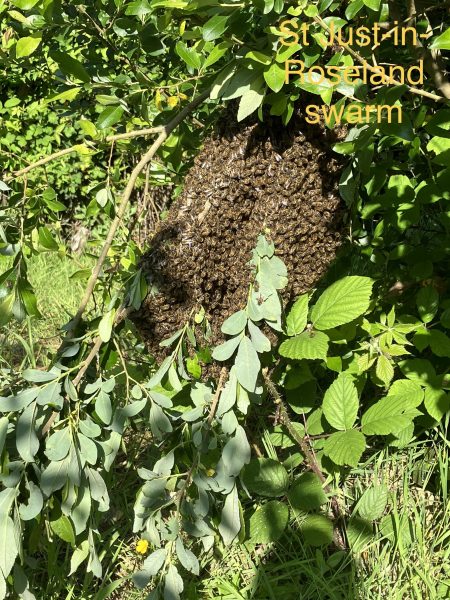
– so considerate, and a cinch to knock into my swarm box – but the swarm was so large I hived it into a jumbo hive to avoid any doubt. Again, they seem very content and are working like the clappers bringing in nectar,
6281
There’s a lot of hawthorn around this year, which not only looks glorious but is a very good source of nectar and pollen for the bees. Unfortunately, not every year is good for hawthorn but perhaps the long, wet winter months were what it likes.
When I went into my apiary to set up the hive for this swarm, I found that one of my own hives had swarmed and the cluster was hanging, very patiently, on the branch of a pine tree that sits in the middle.
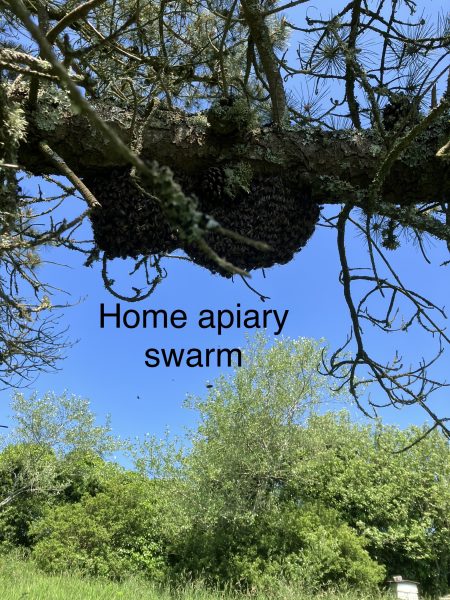
Quite a large swarm, but I hived it in a standard brood box and the bees seem quite happy there.
Finally, two swarms three days apart in my shed roof bait hive. The first quite small, but the second one is massive! I think it’s the biggest swarm I’ve ever collected. I thought about using a jumbo hive but in fact put them in a standard brood box with the intention of giving them another brood box (so making a double brood for their nest which I could then split into two later in the season, though I don’t really want any more hives!). What I am planning now is to build this colony up and use it as a honey producer, so I’ll give them a honey super in the next day or so.
I have been doing other things apart from chasing swarms!
Many of my hives had not received their first honey super yet, so I’ve been placing supers on those colonies that were slower in building up. I noticed one colony in particular was behaving strangely, with piles of bees just sitting on the alighting board, apparently not interested in foraging. I initially thought they might be preparing to swarm but decided I should put a super on them anyway. When I removed the lifts from the hive I was faced with hundreds of bees patiently waiting on the crown-board for me to give them the extra space they needed inside the hive!
They had run out of room to store honey or nectar, so why bother? Once the super was on and the bees brushed into it, things went back to normal and there was no more hanging around the entrance.
So why all these swarms all of a sudden?
I’ve given you one answer already – lack of space!
The queen needs to have plenty of room to lay eggs – she can lay up to 2,000 eggs a day at the height of the season so she’s rapidly approaching that now. Also, there is a massive honey flow on at the moment. The bees need plenty of space to store their gathered nectar before converting it to honey. Nectar is 80% water whilst honey is 80% sugar, so the nectar requires three times the space than the honey does after conversion. That’s a lot of space in a heavy flow. Secondly is the age of the queen. As she gets older the amount of pheromone she produces reduces dramatically and the bees notice this. By swarming, i.e. half the colony leaving the hive with the old queen, the amount of pheromone the queen has left is sufficient to satisfy that half of the colony (the swarm), for a while at least, but during the Autumn the bees will most likely supersede her, producing a new queen to take over from her. In the meantime, the bees that are left in the hive are raising new queens to take over where the old queen left off. The first queen to hatch will then likely kill the remaining developing queens in their cells so that she is still the only queen in the colony. By this means, also, the species is propagated, thereby prevented from dying out as they would surely do if swarming did not occur. Without swarming, we would be left with a static number of colonies, diminishing all the time as colonies died out naturally. Thanks to swarming, the species lives on and grows on an annual basis.
Why do I collect so many swarms when I already have more bees than I need? That is a question my wife asks on a regular (annual) basis. It is purely to save me having to go and remove those swarms that have taken up residence in a roof or chimney or wherever instead of being installed in one of my hives. I obviously wouldn’t have to remove those swarms but as a beekeeper (and this is the same for most beekeepers) I am best skilled to be able to do that compared with the average member of the public. I should mention the fact that I also enjoy it, so it’s pure altruism!
So, not much else to report this month. As you’ve gathered, most other things are on hold until the swarming season (May to July) is over but I’ll keep you updated if things change.
Call if you see a swarm
Call me if you see a swarm hanging nicely in a bush or tree and I’ll arrange for its removal, either by myself or somebody else.
Enjoy the sunshine!
Colin Rees 07939 971104 01872 501313 colinbeeman@aol.com

